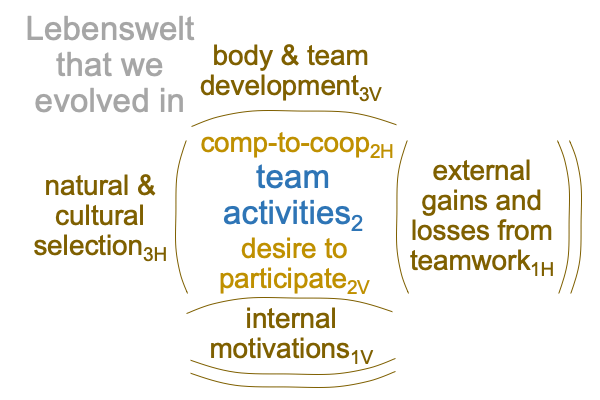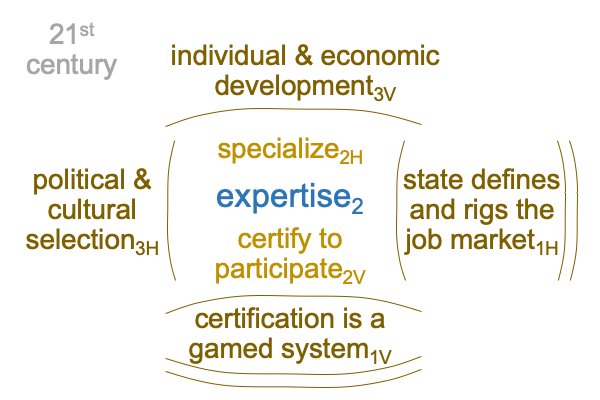0086 In chapters ten (School) and eleven (Becoming Adults), the authors wrestle with 21st century social constructions that do not adequately conform with human adaptations that belong to the Lebenswelt that we evolved in.
On top of that, contemporary grammar schools, high schools and colleges in the modern West are… um… not what they were before 2017.
That ship has sailed.
On all levels, your instructors1H are now assigned2H to inform you, the student, of an actuality2a(1V) that guides the internal dynamics of the postmodern educational system2V: political advocacy.
More on that later.
0087 Former hunters and gatherers face questions, such as, “What are schools supposed to do? Why are the rituals of becoming an adult tied to modern schools?”
Yes, children are raised by parents. But, are schools more than an extension of parental authority? Yes, they are.
In terms of our evolutionary history, childhood and adolescence prepare the individual for a certain degree of specialization, characteristic of team activity.
0088 This allows me to propose, for the authors, an approach to include in their next book. After all, if anything, this examination shows that their guidance is the first step towards an entirely novel curriculum outside the bounds of higher education2.
0089 In the Lebenswelt that we evolved in, children and adolescents are “schooled” in the ways of team activities. Plus, each individual is given opportunities to compete to join a cooperative team. Each individual is expected to exercise his or her talents.
If there is guidance by adults who are not the parents of a child or an adolescent, then that guidance opens a door to joining a team activity. Teacher and student share risks within the team. Every success benefits the team, directly, and all social circles, indirectly. These risks and benefits accrue as the team encounters the world out there (the ecology and environment).
0090 Here is a picture.

0091 At this point, I can see that Heying and Weinstein’s book recapitulates an ancient paradigm, within the hypernovel world of the 21st century.
The student says, “Guide me.” The teacher says, “Join my team.”
Patronize the darkhorse podcast and join the team.
0091 What is team activity2?
Team activity2 is a genus-specific trait2 that regularly entails guidance by non-parental members of a band. Team-activities2 is a single actuality2 that contains adaptations2H and phenotypic traits2V. So, I can place the term, “team activities”, into the slot for “species” in the intersection for biological evolution.

0092 Now, I can make alterations to this intersection, based on literal and metaphorical interpretations of the elements.
0093 First, I alter the potentials, then the other elements of each intersecting nested form, as follows.
The genome1b((1V) decodes DNA2a. Similarly, one’s motivations1b decode one’s talents2a. Talent2a supports an internal motivation to join a particular team1V. The phenotypic expression2V is a desire to participate2V. To participate2V is to belong2 in the normal context of both individual and team development3V.
The niche1b(1H) is the potential of an actuality2a that is independent of the adapting species2a(2H).
What is the actuality that is independent of all team activities?
It is the world out there!
Adaptation2H occurs in the normal context of natural (the individual must perform the appropriate tasks) and cultural (the individual must work for the team and with other team members) selection3H. I call the adaptation competing to cooperate2H. I shorten the slogan to comp-to-coop2H. Comp-to-coop2H coheres to the definitions of direct reciprocity, indirect reciprocity and altruism. Compete-to-cooperate2H explains their evolution. Comp-to-coop2H emerges from (and situates) diverse potentials of the proximate niche1H.
0094 Here is a picture of the adjusted intersection.

0095 Well, this does not look modern at all.
Where are the desks lined up in rows, facing the instructor? Where are the threats by administrators2H for instructors1H to tow the line of the latest trend in advocacy2a(1H)?
Take a look at the corrective sayings that Heying and Weinstein offers as guidance. Do not fear. Respect others. Follow fair rules. Protest unfair rules. Do not get comfortable. Do not get complacent. Take risks.
All these suggestions describe the intersection of team activities2, in the normal context of the Lebenswelt that we evolved in3, arising from the potential of our talents and the world out there1.
0096 How does the current state-supported education system twist our natural being into something that can be controlled in a top-down political regime?
It channels the competition to cooperate2H into state-defined (and regulated) specializations2H. In order to gain entrance into a specialization2H, one must attend school and become certified.
It channels the desire to participate2V into state-defined (and regulated) bodies of knowledge2V. One must go to school in order to achieve certification in regards to that body of knowledge2V. Mastery of the real separates professors2H (pre-2017) from instructors1H (post-2017). State-regulated bodies of knowledge may be real. Or, they may be fictions that high-level administrators want to be advocated. Who knows the difference?
0097 In the 21st century, expertise2 is the single actuality2 that encompasses specializations2H and certification2V.
Here is a picture.

0098 With this diagram in mind, take another look at what Heying and Weinstein have to say.
Plus, consider the trauma that they endured.
Higher education (post-2017) has become a gamed and rigged system.

